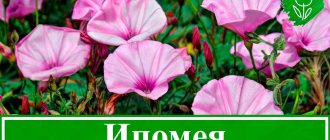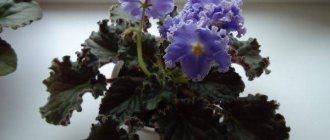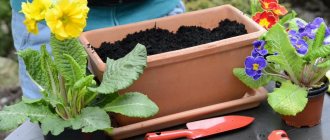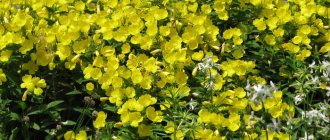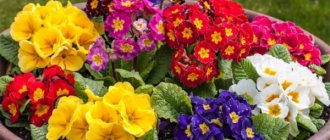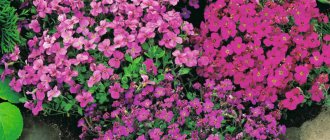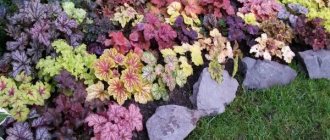Gaillardia is a plant of the Asteraceae family. The birthplace of this flower is America. It grows in the wild in Mexico and the southern United States. Named after Gaillard de Charenton, an eighteenth-century philanthropist who made major contributions to the development of botany.
This plant is the state symbol of Oklahoma. It grows in open areas and during the flowering period colors the fields in a bright fiery color.
Types and varieties of perennial and annual gaillardia: spinous and others
Both perennial and annual species and varieties of gaillardia are popular:
| Kinds | Description | Varieties | Description |
| Beautiful | Annual. An ornamental garden plant with one-color or two-color inflorescences - red at the base and yellow at the edges of the petals. | Red plume | Small flowers of rich red-pink color. |
| Lorenz | The inflorescences are large, with many petals. There are yellow and yellow-red varieties. | ||
| Pictha painted | Red or two-color inflorescences, large, spherical, with a large number of petals. | ||
| Yellow plume | Globular plants with yellow inflorescences, similar to the previous variety. | ||
| Blunt-toothed | Up to 70 centimeters high, with red-brown flowers. Rarely seen. | ||
| spinous | Perennial with dense straight stems, elongated or oval leaves. The flowers are reed-shaped, in rich warm shades. Flowering begins in early summer. | Mandarin | A variety of flower with bright red-orange inflorescences. |
| Wirral Flame | Red flowers with a thin yellowish border. | ||
| Dazzer | Two-color reed variety. | ||
| Hybrid | The result of mixing with other types of flowers. Depending on the variety, there are both tall (up to 80 cm) and short. | Primavera | Low, bushy plants with a large number of peduncles on one seedling. |
| Arizona Sun | Dwarf variety with a long flowering period. | ||
| Sonne | The height of the stem is up to 50-60 centimeters, there are inflorescences with tubular and reed petals. |
Features of the plant
The height of such a plant can reach 0.9 m. It has straight, densely branched shoots, on the surface of which there is pubescence. The alternately arranged simple leaf blades can be lanceolate or oval, they have a jagged edge. Single inflorescences-baskets are located on long peduncles. They consist of red-purple marginal three-toothed flowers, as well as central tubular ones, which most often have a dark red color. There are terry, semi-double and simple baskets. In semi-double inflorescences, reed flowers are placed in 2 or 3 rows. The double inflorescences include overgrown funnel-shaped median flowers. Blooms profusely. The fruit is an achene with a tuft. Beautiful gaillardia is cultivated as an annual, and hybrid gaillardia and spinous gaillardia are cultivated as perennials. Gaillardia is often confused with helenium, but these are 2 different flowers.
Gaillardia is perennial.
Growing gaillardia from seeds, when to plant
Growing from seeds occurs in two ways: seedlings or sowing directly into the ground.
The first method is divided into two stages: preparing seedlings and planting seedlings in the ground.
Sowing seeds for seedlings
Planting is carried out at the end of February or beginning of March. The seeds are not buried, but laid out on the surface of the soil and left in a bright room at room temperature.
The container with seedlings is placed in a place protected from sunlight. Water with a small amount of water as needed.
Gaillardia produces its first sprouts one to two weeks after planting.
Seedling care
After germination of the seedlings, the container with the seedlings is moved to a colder part of the room or to a greenhouse. The sprouts are separated from each other and placed in small containers when the third leaf appears.
Water young plants as the substrate dries. The sprouts must be exposed to light for at least 14 hours a day - you will need to install lamps to create the necessary lighting. The humidity in the room with seedlings should be kept moderate.
How to plant crops correctly?
This plant beauty is planted directly in the sun, and it is necessary to maintain a gap of 25 cm between seedlings. After this, the bed is watered. Before winter sets in, the plants may already be rooted. Gaillardia begins to bloom the next year and grows without transplanting for 4-5 years. Some gardeners argue that it is possible not to produce seedlings, but to sow seeds directly into the ground. In any case, the sequence should be observed: sowing is carried out from July to September, the plants are not buried in the ground. During the first annual period, the plant will give a small “rosette”, and a year later it will bloom fully. But some modern varieties bloom in the first year.
Already in the first year you can expect flowering
Planting gaillardia in open ground
Planting gaillardia does not cause any great difficulties, but you must follow small recommendations regarding planting dates, location and soil.
Landing dates
Strong sprouts are planted in the ground at the end of summer or in September. If planted correctly, the seedlings will have time to take root before the onset of frost and produce eight to ten strong leaves. The plant will bloom next spring.
If you sow flowers directly into the ground, without first growing seedlings, then the right time for sowing is the end of spring. The seeds are planted in shallow holes in the beds, and when the sprouts grow stronger and produce a third leaf, they are transplanted into a flower bed.
Disembarkation rules
Light areas and dry soil are suitable for this plant. The flower does not take root well in soil oversaturated with moisture. Before planting seedlings, the soil is fertilized with a mineral mixture. The concentration of the substance should be low - no more than 40 grams per 1 liter of water. The soil is also fertilized with ash. The distance between seedlings should be at least 20 cm.
Landing
For planting all subspecies, both seeds and part of the mother rhizome (clump) are suitable. Regardless of the method, you need to choose the right place to land. Although Gaillardia is easy to care for, certain rules must be followed.
Drop off locations
The plant is light and heat-loving, so feel free to choose the sunniest areas for planting. The soil should be light, cultivated, with a good drainage system. But there are no special requirements for temperature indicators. It will grow in both dry climates and areas with low temperatures, such as Siberia. The main thing is to ensure mulching with pine needles or peat in the absence of snow cover.
Important: significant humidity, high acidity and an abundance of humus are the enemies of perennial Gaillardia. Planting in such soils is not recommended.
It is better to prepare the landing site as follows:
- prepare a mixture of humus (one bucket), ash (2 handfuls) and complex fertilizer (1 handful);
- apply the mixture to the soil;
- Mark the locations for the holes so that the distance between them is 25 - 35 centimeters.
Note: the amount of mixture is indicated at the rate of one serving per 1 square meter.
The planting technique will depend on which propagation method will be used.
Rhizome and cuttings
The vegetative propagation method allows the use of tubers and cuttings for planting.
- We use rhizome. After 4–5 years of growth in one place, the plant needs to be replanted. At the same moment, it becomes possible to get several bushes from the mother clump. To do this, carefully dig it up and divide it into several parts. The number of daughter parts depends on the size of the curtain. Each must have at least three growth points (a sufficient volume of shoots and roots is a prerequisite for further growth). All parts of the divided clump are transferred to a new location and planted on prepared soil. It is best to plant in the spring, but it can also be planted in the fall, after the plant has finished flowering and has been pruned. When planting in spring, this must be done before active growth begins.
- Cuttings. You can get cuttings before transplanting. To do this, make a dig around the curtain, select large shoots (minimum 50 - 70 millimeters) and carefully separate them. The cuttings need to be grown, so they are not immediately planted in the soil; they are first transferred to a greenhouse.
After planting, seedlings, cuttings and rhizomes require abundant watering.
Seeds
If planting is carried out using seeds, then this can be done in two ways:
- Directly into the ground. To sow ungerminated seeds, prepare shallow furrows (the distance between them should be at least 20 centimeters). If possible, the seeds are distributed as sparingly as possible. After this, the grooves are carefully filled with a rake and watered abundantly. As they grow (for the first time - after 2 - 3 weeks), the sprouts are thinned out and the weeds are removed. If it was not immediately possible to maintain an acceptable distance between the seeds, then the “extra” sprouts need to be replanted. You can sow seeds both in spring and autumn; they will begin to sprout as soon as favorable weather arrives.
- In a greenhouse. Seeds can be initially sown in a greenhouse. To begin with, they are evenly distributed over a damp substrate (over the surface) and sprinkled with vermiculite or nutrient soil. The room temperature should be 20 - 220C, the lighting should be normal, but without direct sunlight. After the sprouts appear, the conditions change:
- optimal temperature 18 – 200C;
- humidity: high, but without “bays”;
- watering: as the soil dries;
- daylight hours: at least 15 hours;
- distance between seedlings: at least 50 millimeters (can be planted in separate plastic cups).
The picking is done after the first pair of leaves has fully developed; subsequently, the seedlings are “hardened off” - taken outside, first for a couple of hours, then for a full day, and finally, with an “overnight stay.”
Important: you can leave seedlings outside overnight only at above-zero temperatures; frosts are detrimental to seedlings. After the plant is ready to stay outside around the clock, it can be planted in soil prepared according to all the rules.
Useful tips
Perennial gaillardia can reproduce by self-sowing. If this is not required, promptly tear off the wilted buds or tie them with gauze to collect the seeds. To obtain more lush bushes, it is allowed to plant several sprouts (from 2 to 4) in one hole.
Since the stems are herbaceous, they need staking (in the case of dwarf species, so that the bush does not “fall apart”, while “giants” need support). Provide garter methods in advance. These can be ordinary sticks or garden flowers with stronger stems (resistant to winds), such as irises.
Please note: when propagated by seeds, daughter flowers may not retain the maternal characteristics, so to preserve the breed, use the vegetative planting method.
Features of gaillardia care
Caring for these plants is not difficult.
Care Tips
To get healthy inflorescences, follow a few simple rules:
- Mineral fertilizers are used to feed gaillardia.
- During the season, fertilize the soil three times: at the beginning of flowering, in mid-summer and after the plant has flowered.
- Regularly loosen and weed the flowerbed. Water with a small amount of water and only in hot and dry weather when the soil becomes dry.
- Tall varieties of perennials require a garter.
Top dressing
To feed plants, mineral complexes such as Kemira universal are used. Compost and humus can also be used as fertilizer.
The main rule is that fertilizers should not increase the acidity of the soil. The use of manure can lead to the development of diseases and death of the plant.
Growing and care
Despite the plant's resistance to cold and heat, planting and caring for perennial gaillardia requires compliance with certain conditions. The shrub easily tolerates heat, strong winds, dry periods, and frosts.
The plant can be grown in moderate climatic conditions in flower beds, front gardens, balconies and terraces. Pots with a diameter of 10 to 13 cm are selected for the plant. Several seedlings can be planted in containers whose diameter does not exceed 16-29 cm. Gaillardia is an unpretentious plant. However, spectacular flowering can be achieved only by providing proper care for the plantings.
The soil
Root system of the plant
For planting gaillardia, choose sunny areas. The plant is not particularly demanding on the composition of the soil. However, the soil must be permeable and light.
Shrubs take deep roots, so areas with heavy soil are not suitable.
Experts recommend draining the places where gaillardia will grow.
It is recommended to prepare the substrate for growing plant seedlings in advance. Plots of land must be well dug up and completely cleared of weeds. To increase the nutritional value, it is recommended to add rotted compost to the soil.
When growing plants in pots or containers, use a soil mixture consisting of peat, perlite or composted bark (no more than 15%), clay (up to 30%). The acidity of the soil should be weak or neutral - pH 5.8-6.4.
Watering
Watering young gaillardia seedlings should be sufficient. Moisten the plantings after the top layer of soil has dried. If the soil is poorly permeable, plants may die in winter without sufficient moisture before frost.
Shrubs tolerate dry periods well. However, plants require sufficient moisture for intensive flowering.
Timely watering guarantees a large number of buds and long flowering.
Fertilizer and feeding
Before planting, the soil is enriched with special additives with a slow release of nutritional components. Apply at least 3 kg of similar flower fertilizer per 1 m2.
For adult plants, multicomponent mixtures are used. Solutions of concentrated fertilizers are prepared according to the instructions on the packages. For young plants, additives are used that contain potassium and nitrogen in a ratio of 1 to 1. Older bushes are fed with fertilizers that contain 2 times more potassium than nitrogen. Organic fertilizers include humus and compost.
An excess of organic fertilizers has a negative effect on gaillardias.
To get green bushes with a minimum number of flowers, add a minimum amount of nutrients to the soil and create a slight lack of moisture.
During the summer, gaillardias are fed up to 3 times. The first feeding is carried out during the formation of buds. The soil is fertilized a second time with the beginning of active flowering. The last time during the season, fertilizing is done after all the buds have withered and been pruned.
Trimming garter
Gaillardia bushes grow more than half a meter high, so they are tied up and periodically pruned. At the end of the flowering period (in September), all buds above the leaves are cut off.
Pruning stimulates plants to grow young shoots from old stems, which improves the quality of flowering in the coming season. Properly pruned gaillardias easily survive wintering.
Many varieties of shrubs require additional support, because their stems reach a height of 0.6-0.7 cm, and large buds can overturn plants. Install support around the bushes using wooden stakes and wire.
Diseases and pests
Gaillardia is resistant to many diseases. If the soil is heavy or often waterlogged, the plant is affected by gray rot, powdery mildew or white rust. The main signs of diseases include changes in the color of leaf blades.
When the first symptoms appear, the affected areas of gaillardia are removed. If a large part of the plant is affected by the disease, the plantings are treated with fungicides. To combat diseases, they use “Hom”, “Oxychom”, “Topaz”, etc.
Whiteflies and aphids are dangerous pests for gaillardia.
To combat a small number of insects, folk remedies are used. When forming large colonies, synthetic insecticides are used, for example, “Decis”, “Akktelik”, etc.
Wintering of perennial gaillardia
The perennial gaillardia flower tolerates cold well. However, when grown in areas with cold climates, plants are additionally covered. Before the onset of cold weather, all flower stalks are removed, and the root collar and roots are additionally covered with spruce paws or fallen leaves. If there is a lot of snow in winter, a snowdrift is made over the plant.
Read about how to extend the life of fragile plants here.
Gaillardia after flowering
Gaillardia blooms until the end of September. In October, seeds can be obtained from not removed peduncles.
How and when to collect gaillardia seeds
To collect seeds, flowers withered in summer are tied with tightly fixed gauze - this prevents unwanted seeds from falling into the soil. The inflorescences are left under gauze until the beginning of autumn, and then collected. A seed that falls naturally into the ground can also sprout in spring, so many gardeners do not resort to hand collection.
The seed method of propagating gaillardia is not popular. Plants grown using this method will differ from the mother plants and will not meet the standards of the variety. To preserve the appearance of the inflorescences, perennial varieties are planted using the bush method.
Preparing for winter
To prepare for winter, you need to separate all flowering shoots a few weeks before the first frost. If the gaillardia was planted only this year, you need to cut off all the stems and sprinkle the bush with dry straw.
Reproduction of gaillardia
Perennial varieties are propagated by the bush method. A strong and healthy bush, growing in one place for five years, is dug up and divided into two or three parts. Each of the shoots must be strong, with durable leaves, capable of taking root in a new bed. Division is carried out at the end of the season, when the plant has completely flowered. All parts are planted in new flower beds.
The root method of propagation is also possible. The large roots of a healthy plant are cut into pieces 5 cm long and then planted in a greenhouse.
Application in landscape design
The use of gaillardia in landscape design is due to the long flowering of shrubs. Plants are used to decorate park areas and flower beds. Gaillardias, whose flowers consist of several shades, are planted in small groups. Against the background of a plain lawn, such plantings look impressive.
Gaillardia in landscape design emphasizes the summer atmosphere. The bushes look great surrounded by other flowering plants. Gaillardia goes well with bells, heuchera, and aster. Dwarf varieties are planted in rock gardens and used to form borders along paths. Photos of gaillardia surrounded by other flowers confirm that it is great for filling empty spaces in flower beds.
Read about what plant is grown to create a hedge here.
Pests and diseases of gaillardia
The main cause of diseases is improper watering and excessively wet soil. The leaves of these flowers are susceptible to diseases such as:
- gray rot;
- rust;
- powdery mildew;
- spotty rashes.
Such diseases are caused by fungi. In the initial stages, the plant can be cured using fungicides (Fundazol, Skor). If the affected area is large, it is recommended to dig up and burn the diseased flower to prevent the fungus from spreading throughout the flowerbed. For preventative purposes, healthy flowers are treated with a solution of potassium permanganate.
The pests that most often cause damage to crops are aphids and whiteflies. Treating the flower bed with insecticides (Aktara, Aktellik) will help against them.
Origin and history of the plant
Gaillardia Arizona is one of the brightest representatives of the Astrov family. The flower is a symbol of Oklahoma. In the wild, the plant grows in South and North America.
Gaillardia received its name in honor of Gaillard de Charentoneau, a philanthropist who patronized the study of the plant world.
According to the description, Arizona Sun gaillardia looks like a ball of fire. Brightly colored flowers are found in the wild along railroad tracks, in pastures, meadows, and beaches. Gaillardia grandiflora is grown in home gardens.
